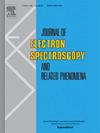XPS study on the oxidation-induced segregation behavior of U–Nb alloy
IF 1.5
4区 物理与天体物理
Q2 SPECTROSCOPY
Journal of Electron Spectroscopy and Related Phenomena
Pub Date : 2025-01-01
DOI:10.1016/j.elspec.2024.147513
引用次数: 0
Abstract
In this work, the surface structure and chemical composition of U–Nb alloy after one year of oxidation under ambient conditions were investigated using X-ray photoelectron spectroscopy (XPS) depth profile methods. Furthermore, the in-situ oxidation of U–Nb was carried out under UHV conditions, providing insights into the initial oxidation behavior of U-Nb. Studies show that, an thin (1.5 nm) layer of UO2 intermixed with enriched Nb2O5 is formed on the top of the naturally oxidized U–Nb, with an inner oxide layer consisting of UO2-x intermixed with depleted NbO2 and NbO at below, followed by an inner layer of UO2-x intermixed with metallic U and Nb adjacent to the U-Nb substrate. During the initial oxidation stage, U oxidizes rapidly to form UO2-x, while the leaving Nb in the UO2-x lattice migrates inward and enriched at the metal side of the oxide/metal interface. As oxidation continues, oxidation-induced segregation of the leaving Nb in the UO2-x lattice toward the surface occurs and forms NbO and NbO2 at the gas-oxide interface. The affinities of U and Nb to OH and O anions may act as the driving force of the segregation.
U-Nb合金氧化致偏析行为的XPS研究
本文采用x射线光电子能谱(XPS)深度剖面法研究了常温氧化一年后的U-Nb合金的表面结构和化学成分。此外,在特高压条件下进行了U-Nb的原位氧化,为U-Nb的初始氧化行为提供了见解。研究表明,在自然氧化的U-Nb表面形成一层厚度为1.5 nm的UO2与富集Nb2O5混合薄层,其下为UO2-x与贫NbO2和NbO混合的内氧化层,U-Nb衬底附近为UO2-x与金属U和Nb混合的内氧化层。在初始氧化阶段,U迅速氧化形成UO2-x,而留在UO2-x晶格中的Nb向内迁移并富集在氧化物/金属界面的金属侧。随着氧化的继续,氧化引起的在UO2-x晶格中留下的Nb向表面偏析发生,并在气-氧化物界面形成NbO和NbO2。U和Nb对OH和O离子的亲和力可能是分离的驱动力。
本文章由计算机程序翻译,如有差异,请以英文原文为准。
求助全文
约1分钟内获得全文
求助全文
来源期刊
CiteScore
3.30
自引率
5.30%
发文量
64
审稿时长
60 days
期刊介绍:
The Journal of Electron Spectroscopy and Related Phenomena publishes experimental, theoretical and applied work in the field of electron spectroscopy and electronic structure, involving techniques which use high energy photons (>10 eV) or electrons as probes or detected particles in the investigation.

 求助内容:
求助内容: 应助结果提醒方式:
应助结果提醒方式:


